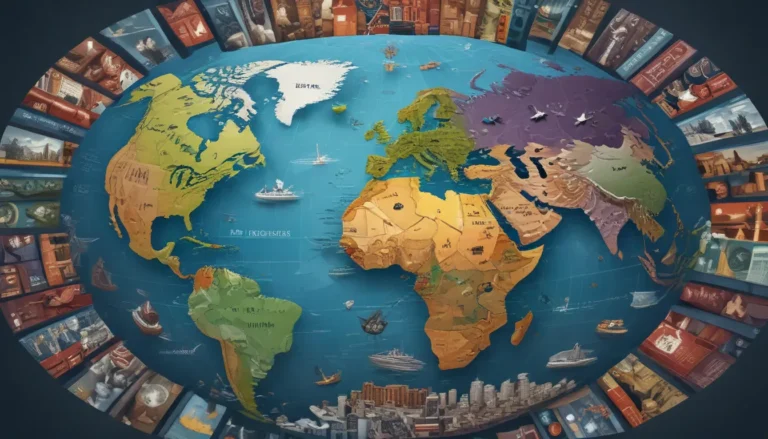A Note About Images: The images used in our articles are for illustration purposes only and may not exactly match the content. They are meant to engage readers, but the text should be relied upon for accurate information.
Spatial patterns are all around us, shaping the world we live in and offering unique insights into the organization and distribution of Earth’s physical and human features. From the arrangement of cities to the distribution of natural resources, spatial patterns provide a lens through which we can better understand our environment. In this article, we will delve into the captivating world of spatial patterns and uncover 11 astounding facts that showcase the complexity and significance of this field.
The Beauty of Natural Spatial Patterns
- Natural Phenomena: Spatial patterns manifest in various natural processes, from the distribution of plant species in a forest to the formation of sand dunes in a desert. These patterns reveal the intricate beauty and underlying processes of our natural world.
The Intriguing World of Fractals
- Fractals: Fractals are captivating geometric shapes or patterns that exhibit self-repeating properties. From the branching of trees to the irregular coastline of a country, fractals can be observed at different scales, highlighting the complexity and beauty of our environment.
Applications of Spatial Patterns in Urban Planning
- Urban Planning: Spatial patterns play a crucial role in urban planning, influencing the design of cities and towns. By optimizing the arrangement of roads, buildings, and public spaces, urban planners aim to create functional and visually appealing environments that enhance the quality of life for residents.
The Role of Spatial Patterns in Crime Analysis
- Crime Analysis: Law enforcement agencies use spatial patterns to analyze crime hotspots, understand criminal behavior, and allocate resources effectively. By mapping crime incidents and examining their spatial relationships, analysts can provide valuable insights for crime prevention strategies.
Influence of Spatial Patterns on Transportation Networks
- Transportation Networks: Spatial patterns impact the layout of transportation networks, including road systems and public transit. Factors such as population density and geographical features play a key role in determining the efficiency and accessibility of transportation systems in a given area.
Conservation Efforts Through Spatial Patterns
- Wildlife Conservation: Conservationists utilize spatial patterns to understand habitat connectivity, species distributions, and the impact of human activities on wildlife populations. By analyzing these patterns, conservation efforts can be targeted towards preserving biodiversity and protecting critical habitats.
Economic Implications of Spatial Patterns
- Economic Analysis: Spatial patterns are studied in economics to analyze resource distribution, income inequality, and regional development. Understanding these patterns helps policymakers make informed decisions regarding resource allocation, infrastructure development, and economic policies.
Social Dynamics Revealed Through Spatial Patterns
- Social Networks: Social networks exhibit spatial patterns, with individuals forming clusters, communities, and interconnected networks. Examining these patterns provides insights into social dynamics, information flow, and the spread of ideas within a population.
Analyzing Spatial Patterns Using GIS Technology
- Geographic Information Systems (GIS): GIS technology allows researchers to capture, analyze, and visualize spatial patterns using geospatial data. By overlaying different layers of information, spatial relationships and patterns can be identified, aiding decision-making processes across various fields.
The Multiscale Nature of Spatial Patterns
- Different Scales: Spatial patterns exist across a wide range of scales, from atomic arrangements to galaxy clusters. Exploring these patterns at various scales helps unravel the complexities of our world and its interconnected systems.
Artistic Inspiration from Spatial Patterns
- Artistic Expression: Artists draw inspiration from spatial patterns, integrating them into paintings, sculptures, and architectural designs. By capturing the harmony and uniqueness of these patterns, artists create visually stunning works that resonate with viewers.
Unlocking the World of Spatial Patterns
From the mesmerizing arrangement of stars in the night sky to the organized distribution of vegetation on Earth, spatial patterns offer a window into the underlying dynamics of our environment. Understanding spatial patterns is not only crucial for geographers and scientists but also for urban planners, architects, and everyday individuals. By recognizing and appreciating the patterns that shape our surroundings, we can make informed decisions about sustainable development and resource management.
FAQs about Spatial Patterns
-
What are spatial patterns?
Spatial patterns refer to the organized arrangement of objects or phenomena in a given space, found in natural and human-made systems. -
How do fractals relate to spatial patterns?
Fractals are complex shapes that exhibit self-similarity at different scales, helping us understand the repetitive nature of spatial patterns. -
Why is studying spatial patterns important?
Studying spatial patterns provides valuable insights into ecosystems, human activities, and resource management, guiding informed decision-making. -
How are GIS used in analyzing spatial patterns?
GIS technology enables the collection and visualization of spatial data, helping researchers analyze and understand spatial patterns. -
Can spatial patterns be found in urban areas?
Yes, spatial patterns are prevalent in urban areas, influencing the layout of streets, buildings, and land uses. -
How can individuals benefit from understanding spatial patterns?
Understanding spatial patterns helps individuals make informed decisions about their surroundings, from choosing a location to planning a commute.
Embrace the intricate beauty and functionality of spatial patterns, and join us in exploring the world of spatial organization and distribution. Through continued research and exploration, we will deepen our understanding of this fascinating field and its implications for the future.






